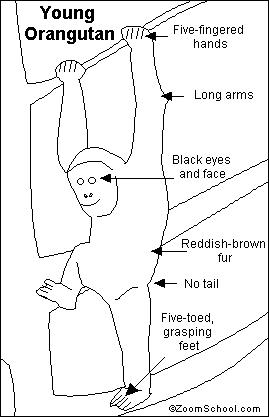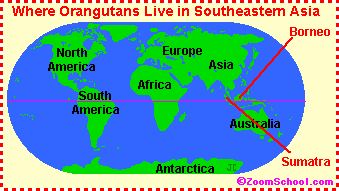Advertisement.
EnchantedLearning.com is a user-supported site.
As a bonus, site members have access to a banner-ad-free version of the site, with print-friendly pages.
Click here to learn more.
(Already a member? Click here.)

 Orangutans are large apes that live in southeast Asia (on the islands of Borneo and Sumatra). These apes mostly live in trees (they are arboreal) and swing from branch to branch using their arms.
Orangutans are large apes that live in southeast Asia (on the islands of Borneo and Sumatra). These apes mostly live in trees (they are arboreal) and swing from branch to branch using their arms.
The word orangutan means "man of the forest" in the Malay language. As its habitats are being usurped by man, the orangutan's population is decreasing and it is in grave danger of extinction.
ANATOMY
Orangutans have a large, bulky body, a thick neck, very long, strong arms, short, bowed legs, and no tail. Orangutans are about 2/3 the size of the gorilla.
Hair:
They are mostly covered with long reddish-brown hair.
The Head:
The orangutan has a large head with a prominent mouth area. Adult males have large cheek flaps (which get larger as the ape ages).
Senses:
Orangutans have senses very similar to ours, including hearing, sight, smell, taste, and touch.
Hands and Feet:
Orangutan hands are very much like ours; they have four long fingers plus an opposable thumb. Their feet have four long toes plus an opposable big toe. Orangutans can grasp things with both their hands and their feet. The largest males have an arm span of about 7.5 feet (2.3 m).
SIZE
Orangutans are about 2/3 the size of the gorilla.
| Orangutans | Height | Weight |
| Female | 2.6-3.5 ft (0.8-1.1 m) | 110 lb (50 kg) |
| Male | 3.2-4.5 ft (1-1.4 m) | 200 lb (90 kg) |
DIET
Orangutans are omnivores (they eat both plants and animals) but are mostly herbivorous (plants comprise most of their diet). They eat fruit (their favorite food), leaves, seeds, tree bark, plant bulbs, tender plant shoots, and flowers. They also eat insects and small animals (like birds and small mammals).
Orangutans don't even have to leave their tree branches to drink, they drink water that has collected in the holes between tree branches.
INTELLIGENCE AND LANGUAGE
Orangutans are very intelligent. They have been known to use found objects as tools; for example, they use leaves as umbrellas to keep the rain from getting them wet. They also use leaves as cups to help them drink water.
BEHAVIOR AND SOCIAL HABITS
Orangutans are shy, solitary animals that are active during the day (they are diurnal). They live alone in large territories. This is probably due to their eating habits; they need a large area in order to get enough food and too many orangutans in one area might lead to starvation.
The only long-lasting orangutan social group is the mother and offspring, who live together for about 7 years. When mating, the male and female orangutan stay together for only a few days.
Sleeping Platforms:
Each evening, orangutans construct a "nest" in the tree branches for the night in which they will curl up and sleep. These nests are made out of leaves and branches. Nests are shared by a mother and her nursing offspring. Sometimes, the orangutan will use a leaf as a "roof" to protect itself from the rain. Orangutans often nap in the afternoon after a morning spent obtaining food.
COMMUNICATION AND VOCALIZATION
Male orangutans are capable of very long, loud calls (called "long calls") that carry through forests for up to 0.6 mile (1 km). The "long call" is made up of a series of sounds followed by a bellow. These calls help the male claim his territory, call to females, and keep out intruding male orangutans. Males have a large throat sac that lets them make these loud calls.
LOCOMOTION
 Orangutans usually move by swinging from one branch to another; this is called brachiating. Orangutans can also walk using their legs (but rarely do). Orangutans do not swim.
Orangutans usually move by swinging from one branch to another; this is called brachiating. Orangutans can also walk using their legs (but rarely do). Orangutans do not swim.
LIFE SPAN
Orangutans live about 50 years in captivity; their life span in the wild is only 30-45 years (like most animals, they live longer in captivity).
HABITAT
Orangutans live in tropical rain forests.
DISTRIBUTION
 Orangutans live in Asia. They are the only great ape from Asia. They are found in tropical rain forests in northern Sumatra, Indonesia and in low-lying swamps in Borneo.
Orangutans live in Asia. They are the only great ape from Asia. They are found in tropical rain forests in northern Sumatra, Indonesia and in low-lying swamps in Borneo.
REPRODUCTION AND BABY ORANGUTANS
Orangutans are mature and capable of reproducing beginning when they are 7 to 10 years old. Females are pregnant for 8.5 to 9 months and give birth to a single baby. Young orangutans are weaned from their mothers at about 6-7 years of age.
NATURAL ENEMIES
The animal that poses the biggest threat to the orangutan is man (who uses its habitat and sells young orangutans as pets).
POPULATION
Orangutans are an endangered species. They are decreasing in numbers quickly as they lose habitat to people. Further aggravating the problem, baby orangutans are caught and sold around the world as pets.
THE EVOLUTION OF ORANGUTANS
The earliest-known primates date from about 70 million years ago (Macdonald, 1985). The greater apes (family Pongidae, gorillas, chimpanzees, bonobos, and orangutans) split off from the lesser apes (family Hylobatidae, gibbons and siamangs) 20 million years ago.
CLASSIFICATION
Orangutans belong to the:
- Kingdom Animalia (all animals)
- Phylum Chordata
- Subphylum Vertebrata (animals with backbones)
- Class Mammalia (warm-blooded animals with fur and mammary glands)
- Order Primates (which includes 11 families, which include lemurs, monkeys, marmosets, lesser apes, great apes, and humans)
- Family Pongidae (the great apes, including gorillas, chimpanzees, bonobos, and orangutans)
- Genus Pongo (gorillas and orangutans)
- Species pygmaeus
Subspecies or Not?
Some scientists think that these two groups of orangutans are different subspecies (a subdivision of a species), others think that they are not. Since these two groups of orangutans have been geographically separated for a long time, they are now physically distinct from each other. They are not different species since they are genetically similar enough to interbreed.
Enchanted Learning®
Over 35,000 Web Pages
Sample Pages for Prospective Subscribers, or click below
Click to read our Privacy Policy
Enchanted Learning Search
|
Search the Enchanted Learning website for:
|
Advertisement.
Advertisement.
Copyright ©1999-2018
EnchantedLearning.com ------ How to cite a web page

